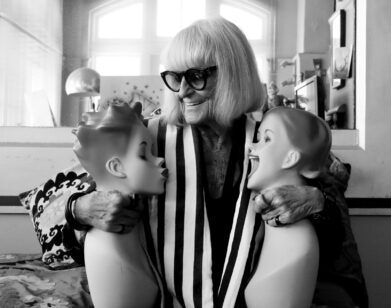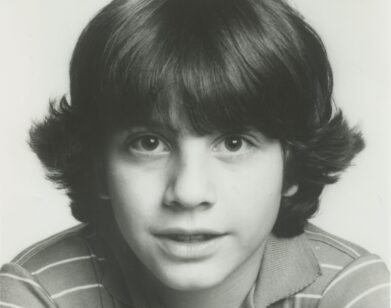Raf Simons and his friend, the artist George Condo, on Warhol and the rest of the World
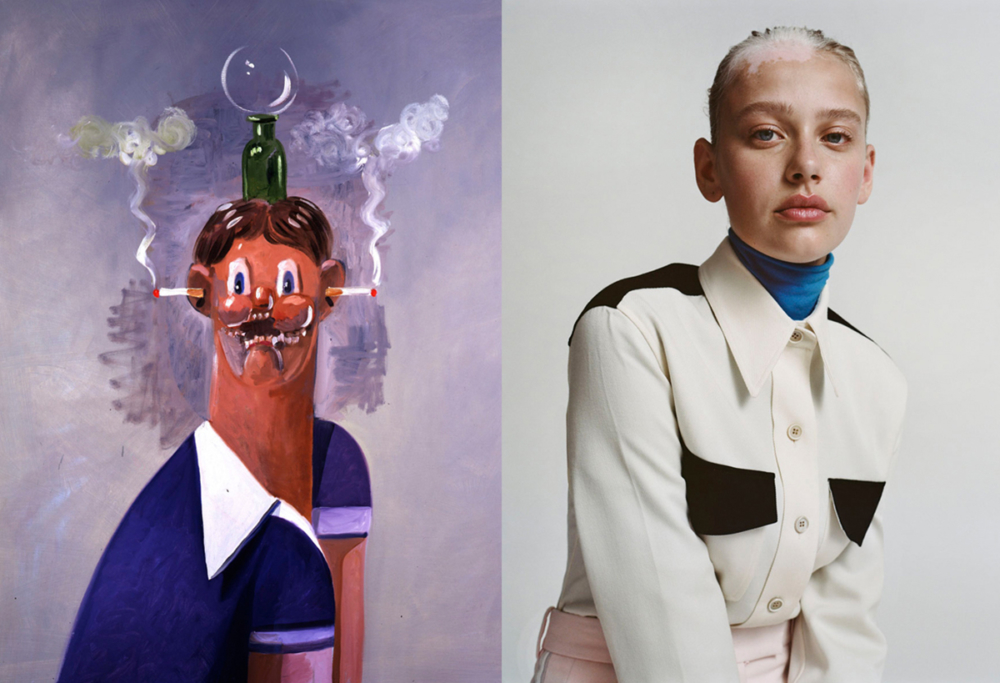
I was first confronted by a George Condo painting in 2006. I say “confronted” because, of course, I had been familiar with the 60-year-old artist’s work—his grotesquely chipper portraits of colorful, somewhat cubist characters—for much longer than that. But it was “Writer,” an oil rendering of a snarling man in repose, a notepad on his swollen gut and a pencil in place of his penis, that reflected back to me a version of myself that I was not ready to explore. The pen might be mightier than the sword, but in this case, the sword, so to speak, had been removed entirely.
It wasn’t until 12 years later that such a menacing mirror was once again held up to my face. It was last February at the American Stock Exchange, where Raf Simons, the Belgian designer whose career has included appointments at Jil Sander and Dior, was presenting his third runway show for Calvin Klein. The floor of the event space was a swampy glut of popcorn. Piercing reverb punctuated the soundtrack to the evening. And as the models walked through the room, dressed alternately in prairie dresses and oddly militaristic balaclavas, an Andy Warhol painting—rendered much too large on the façade of a barn—of Sandra Brant, formerly a publisher of this magazine, presided over the crowd who had assembled there that night to look at clothing. The American dystopia had arrived, Simons, age 50, seemed to suggest. And we were it.
It was with these two recollections in mind that I arrived on an afternoon in July, dangerously sweaty, to the Calvin Klein offices in Midtown Manhattan for lunch with Condo and Simons. Although our conversation sometimes looked down some of the darker corridors of contemporary culture, we mostly talked about the similarities in their practices, the opera they’re working on together, and the incomparable pleasure of watching a dumb movie over and over again.
———
GEORGE CONDO: I have a rental in East Hampton, but I didn’t get out there at all last year. Everybody talks about going off-season, but I barely ever do. I’m so busy the rest of the year with exhibitions, and whenever I do go, I have to drag my assistants out with me. Ultimately, I end up feeling like a chef because I’m always cooking for everyone.
RAF SIMONS: You’re a fantastic cook.
CONDO: I’m seasonal. In the winter, I like to make beef bourguignon.
SIMONS: Or meatballs.
CONDO: Heavy food. In the summer, I try to eat South of France–style food.
NICK HARAMIS: What about you, Raf? Do you cook?
SIMONS: Never. Except during the holidays when I can take my time and it becomes a calming thing. But not when I arrive home at 9 o’clock and have to start thinking about what to eat.
CONDO: The great thing for me about cooking is that it’s kind of like making a painting that you get to eat when you’re done.
HARAMIS: Speaking of art, tell me about the opera you’ve both been working on.
CONDO: Anthony Roth Costanzo is an amazing countertenor, and this is an opera that involves the music of Philip Glass and [George Frideric] Handel. Anthony and I go back a while. Actually, the first time Raf came over, Anthony and I performed two or three songs because I wanted him to hear Anthony’s voice, how exquisite his tone is. Anyway, Anthony was telling me about the 56-piece orchestra involved in the project, and how he wanted to find somebody to do costumes. So I said, “Why don’t I ask Raf if he might be interested?” Maurizio Cattelan and Justin Peck are also involved, so I thought he very well could be, too.
SIMONS: And now it’s coming together.
CONDO: I was asked if I’d consider doing the set design, and I realized that what I really wanted was to do a live painting. But I didn’t want to have to get up there in front of an audience. That’s the last thing I’d ever want to do. Now they’ve added a screen, so that I appear onstage only as a shadow.
SIMONS: I think it’s going to be a very new experience for the audience. Everything is alive.
CONDO: For me, it’s going to be a completely improvisational experience. I basically have 55 minutes to do whatever I want, and that’s exciting. A violinist could break a string. Anthony could cough. I could spill a bottle of paint. Somebody could rip a dress.
SIMONS: What interested me was the collaboration. Having everything focused 100 percent on your own thing can be quite fatiguing. With this project, I never had any intention of taking over. It’s like when I worked on I Am Love [a 2009 film by Luca Guadagnino, which included Simons’s designs for Jil Sander]—I wasn’t going to take over. I was just part of a team.
CONDO: My favorite part about this project is the amount of risk involved. Here’s to not fucking the whole thing up!
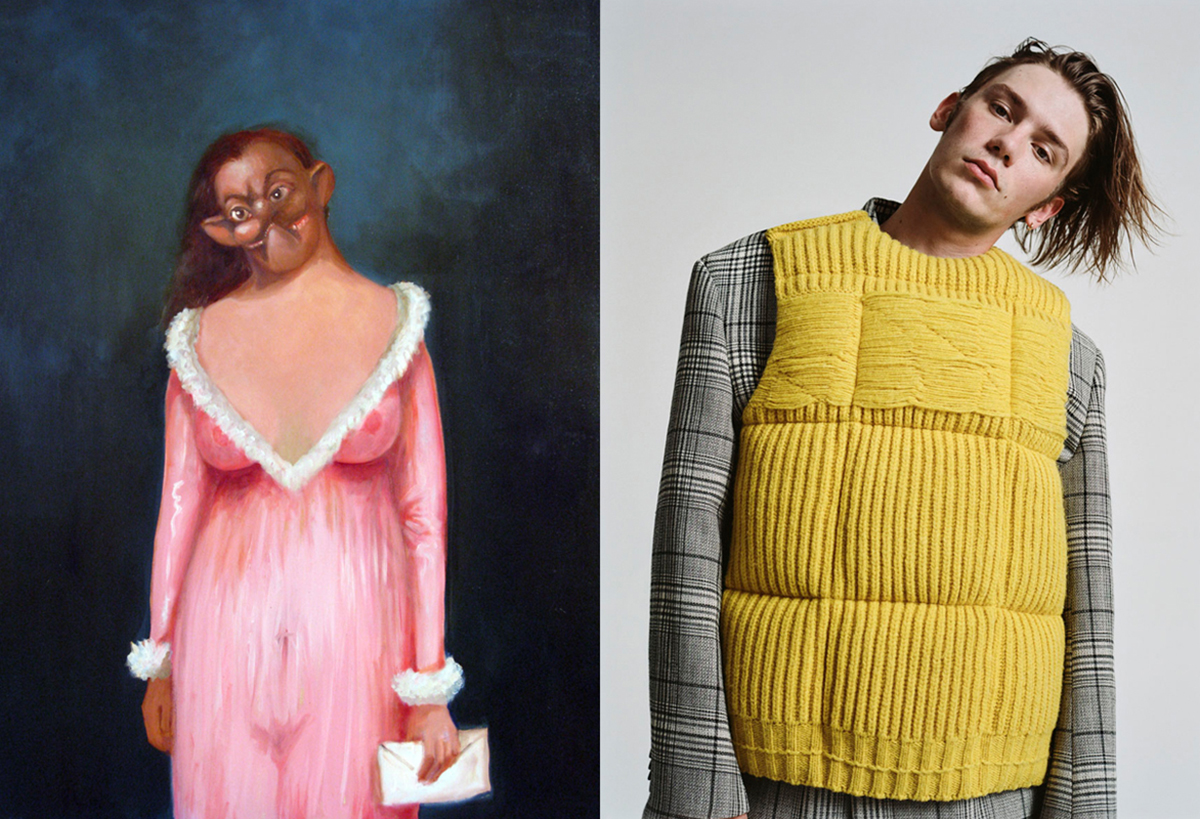
Left: George Condo. “The Letter,” 2010. Right: Luca Wears a Vest and Coat by CALVIN KLEIN 205W39NYC
HARAMIS: Raf, what are you like under pressure? I watched you keep it together in Dior and I, the 2014 documentary in which you had, like, 15 minutes to create your first couture collection for the house.
SIMONS: I get more stressed when I think about all the people who surround what I’m doing, and who are affected by it. In my daily activity, I don’t really feel that so much.
I’m friends with a lot of designers who I know don’t like to do a show—especially the five or six days of prep before a presentation. Me, I’m the opposite. It’s my favorite period. It’s the show day itself I don’t really like. Leading up to it, there is not a second when I’m not on high alert. I’m happy to work through the night, no problem. But on show day, especially about an hour before the show, everything needs to happen. Nothing can go wrong. And then right after the show ends I have to stand next to all these people looking like an idiot, all sweaty and awkward. I can’t have a decent conversation. It’s especially tough when you’re still the new guy. I don’t know how to say it in English, but people have…
HARAMIS: Expectations?
SIMONS: Exactly. When I went to Jil Sander in 2005 after designing only for men for over a decade, everybody was like, “Show it to me, baby. Let’s see if you can do women.” That, of course, creates tension. A similar thing happened when I came to the American market.
HARAMIS: At a certain point, do you stop feeling the need to prove yourself?
SIMONS: Never. Then I would quit. I’m always thinking about my audience.
HARAMIS: Who is your audience?
SIMONS: These days, the audience is everybody.
CONDO: Everyone who passes a Calvin Klein billboard, or looks at a picture online.
SIMONS: New media and the selfie mentality have created a different kind of dialogue, one that’s a lot faster.
CONDO: If I go to an event that I’m involved with, 80 percent of the people who come up to me basically just want to get a picture for Instagram. And that’s as far as they go critically. The critical aspect of the work is far less important than the pure, self-serving aspect of grabbing me in a corner and saying, “Can I take a picture of you with my wife?”
HARAMIS: Do you oblige?
CONDO: I always say yes. But it can get weird. A while back, I was walking out of the Ritz in London and this guy, a graffiti artist, came up to me and said, “Hey, George. Let me get a picture of you and me in front of this Rolls-Royce.” Next thing I know, he’s got his arm around me, wearing shades, a Rolls-Royce in the background. Within a few seconds, he captured a moment in time that is also a complete fabrication
of reality.
SIMONS: It’s definitely taken me by surprise before. I was in the fitting room of a store, peeping out to say something to my partner, and somebody was just waiting there for me.
I was barely dressed.
HARAMIS: Social media really cemented Andy Warhol’s prediction that at some point everyone would be famous for 15 minutes.
SIMONS: I’ve always been fascinated by Warhol. I mean, I feel a little fragile talking about it, because I’m sitting with someone who actually knew him. But what’s always resonated with me about him was this sense that he had no fear—at least that’s how the work feels to me. He didn’t seem to care if his work was complicated to look at, or if it conformed to the rest of the world, but at the same time it was both easy and commercial. He changed art.
CONDO: I wasn’t around in the ’60s or ’70s, so everything I knew about Andy Warhol was formed before I ever met him. I already had a perception of him as an incredibly important American artist. What was fascinating to me was how he simplified culture. That resonated with people, in either a controversial or a positive way. The great thing about Andy was that he was controversial and positive simultaneously. Even if he was talking about the race riots in Alabama, he was doing something positive by bringing awareness to something so horrible. And he anesthetized it in such a way that it was unique and new and interesting.
The idea that he ran a factory, that he never touched the work, that it was done in this completely objective way so that somehow he was able to free himself from the experience of early modernism—it was as if to say, “I’m an artist who doesn’t paint. I make paintings, but I don’t paint them.” He eventually built this language that was easily identifiable—the celebrity portraits, the Campbell’s soup can. With Andy, it was just funny that he would choose a Campbell’s soup can. And he would always say something relatively self-deprecating about it, simplifying the reason for doing it: “I painted some Campbell’s soup because my mother said when I didn’t know what to paint, to paint what I like, and I like Campbell’s soup.”
But it was always far more intellectual in reality than how Andy put it. Another thought that comes to mind is that when you go to a souvenir shop anywhere in the world, you’ll see something like a little Empire State Building. You’ll see a little Michelangelo or a little Eiffel Tower—it’s only the most important things that make it to the souvenir shop. I think what Andy wanted to do with people like Marilyn Monroe was to create a kind of souvenir of them, to the extent that their whole life was encapsulated in that single image.
HARAMIS: I’d say he succeeded.
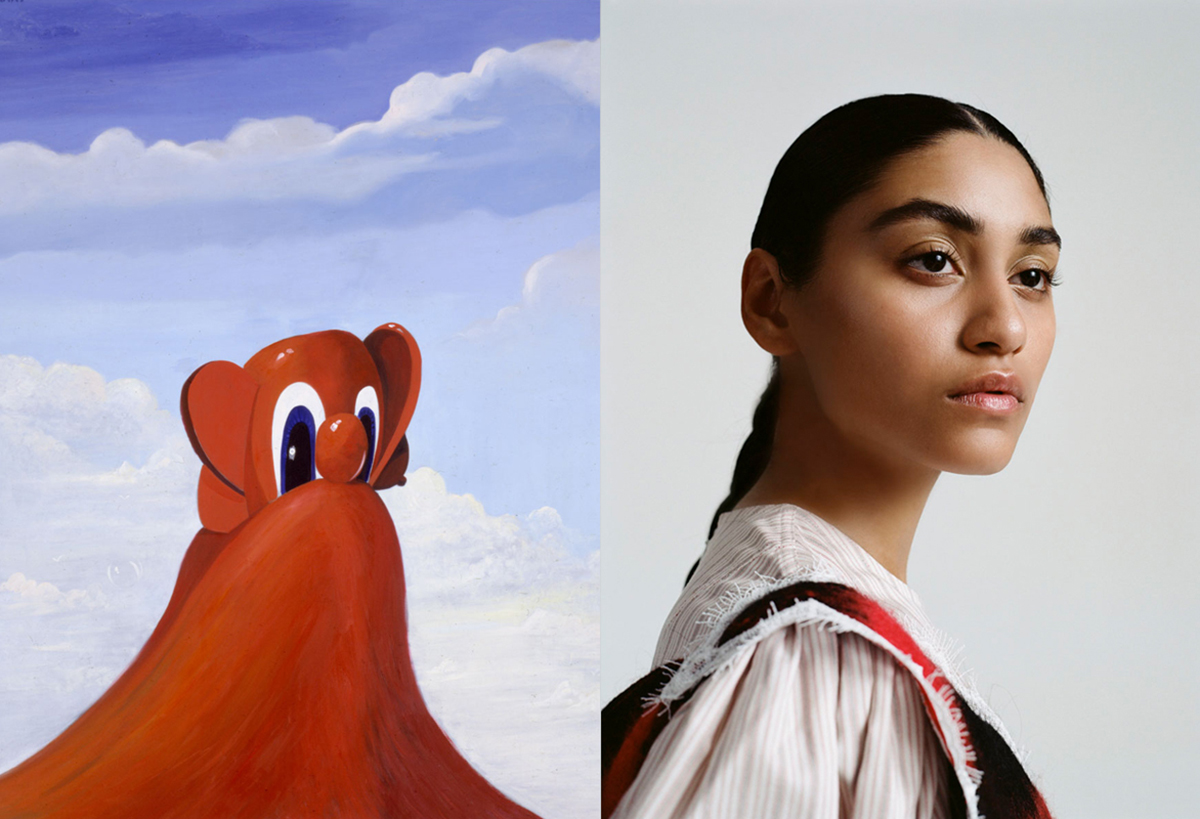
Left: George Condo. “Big Red,” 1996–97. Right: Alvina Wears a Dress and Dress (worn underneath) by CALVIN KLEIN 205W39NYC
CONDO: When I worked at the Factory, he was so in control of everything all the time. Regardless of whether he did it or not, he would tell you exactly what shade of orange he wanted. There was a cabinet where I’d have to go grab the paint. The paint cans were all labeled, like, “Liz Taylor Green” or “Marilyn Orange 1962.” Sometimes he’d say, “Don’t use the Marilyn lip on her. She doesn’t deserve them.”
HARAMIS: Like Warhol, you both seem interested in high art and mass culture in a way that feels almost democratizing. Where does that impulse come from?
SIMONS: For me, it’s simple. One doesn’t exist without the other.
CONDO: Pop is not the first place where high and low have come together. It’s just the first place where the discussion of high and low became something that the critics were able to grab onto. Before that, it was comic strips and Richard Hamilton and other people like him in London, who started to come up with this different way of taking the ordinary and incorporating it into the extraordinary. It’s the idea of taking something from one context and transforming it into a completely different context without rearranging the pieces. And the judgment of an artwork is always contingent on its audience. They will read it based on their own quantity of knowledge. No matter what you explain to them, they’re going to experience it on their own terms. People have said about my work that it’s like Bugs Bunny painted by Rembrandt.
HARAMIS: When we first started talking about Warhol, Raf, you had said that it was his lack of fear that appealed to you. Is that something to which you aspire?
SIMONS: Well, it’s complete bullshit. We’re all scared like crazy. But what I meant is that it doesn’t show in his work. It’s like the very opposite of fear. It’s courageous work—maybe he was courageous, too. I’m not sure, because I didn’t know him. Besides, who ever knows that about anybody?
CONDO: He was afraid of everything but the art. It’s like you on show day, Raf—the discomfort that comes when the work is done. It’s like having people over for dinner, and being afraid that the food that you’ve cooked is no good.
SIMONS: It doesn’t matter if the creative animal has fear. It’s more important to analyze if the body of work shows weakness and fear or has a lot of strength. That’s the thing that’s in dialogue with the audience.
CONDO: I like the fear. It’s why I like watching TV shows like Naked and Afraid, where they go out into the wilderness for three weeks. I often imagine how great it would be to try, but I’d never actually do it.
HARAMIS: It’s always the really scared ones who survive. The outwardly confident guy, the one who’s learned everything he knows from watching YouTube videos, is usually the one who gives up on the first night.
CONDO: Yeah, that guy only lasts ten minutes.
SIMONS: I’ve been watching The Handmaid’s Tale, a series that’s all about fear.
HARAMIS: Wait, it’s so weird you bring up that show. I had a dream last night that you asked me to walk in the next Calvin Klein show dressed as a handmaid, and waiting at the end of the runway was a noose.
[Sorbet is served at the table]
SIMONS: Sorry, what were you saying?
HARAMIS: Nothing. Go on, please.
SIMONS: It’s such an incredibly well-done show—the dialogue, the music, the acting, the environment, the color. Each episode is so good that I find it difficult to stop watching. I haven’t felt that way about a show in a while. Not since I watched Twin Peaks in college.
HARAMIS: Is TV your preferred outlet for escape?
SIMONS: Not exclusively. I go to the movies a lot.
CONDO: I lost my ability to go to the movies a while ago. I have to know how it ends in order to see it. I need to know the twist. What I used to love most about going to the movies was the previews. When the movie finally starts, I’m always like, “What’s gonna happen to her? What’s gonna happen to him? Is he gonna kill her? Is she gonna kill him? What are they gonna do? Who’s the bad guy? Who’s the good guy? Oh, it’s not that kind of movie? Okay.”
SIMONS: I’m the exact opposite. I don’t want to watch the movie if somebody’s spoiled the ending. But once I’ve seen a movie I like, I can watch it 50 times.
CONDO: I caught Dumb and Dumber on TV the other day. I hadn’t seen it in so long, and it was shockingly funny. Fifteen minutes in, I was wishing for Jim Carrey to come back to movies. He was so good. His character has been sitting at the bar for maybe six hours, and the bartender gives him a beer and says, “Hey, I feel bad for you, buddy. I know you’re waiting for a date.” And Jim Carrey says to him, “Well, you know how woman are. Everything has to be perfect.” The idea that any woman would be sitting in front of a mirror for that long for him is just so absurd.
SIMONS: What are your three favorite movies?
CONDO: I love [Alfred] Hitchcock’s The Birds. It was Jean-Michel Basquiat’s favorite movie, too. I remember asking him, “What’s your favorite part?” And he described the bit when the guy goes to the gas station, and everybody’s in the window going, “No! No! No!” And he lights up a cigarette and the whole place blows up. The way it’s shot is like a [William] Eggleston. I also love Apocalypse Now. And I love [Stanley] Kubrick. What’s a movie that stands out to you from when you were a kid?
SIMONS: Jaws is number one. It cannot be beaten by anything else. E.T. is another one. I had to be carried out the first time I saw it because I was crying so hard.
CONDO: I recently watched a BBC documentary about the last years of [Pablo] Picasso’s life, and his grandson Bernard, who’s a good friend of mine, was saying that his grandfather loved to watch television, specifically The Three Musketeers. They cut to film footage from that particular show—with the swords, the outfits, the gestures, and the expressions—and then they showed Picasso’s paintings from that era, and it made so much sense.
SIMONS: People tend to want to intellectualize a body of work, when often it can be born out of a single thought—as simple as a gesture.
CONDO: Sometimes you don’t need to visit the pyramids to be inspired. Sometimes you just have to go to the beach and have an ice cream.
SIMONS: People often ask where I get my inspiration—
CONDO: The worst question someone can possibly ask.
SIMONS: It’s impossible to answer. But the one thing I always say is that it’s never something that I’m actively searching for while sitting at a desk. It used to freak me out that ideas would come out of nowhere, because I’d have to write them down right away so I wouldn’t forget them. It still happens, say, when I’m in a movie or something, just plop. It has nothing to do with the movie. Just plop.
———
Models: Tia Jonsson at Anti-Agency, Luca Bertea at DNA Models, Alvina Bokhari at Anti-Agency
Hair: Recine using Recine for Rodin at The Wall Group
Makeup: Grace Ahn at Julian Watson Agency
Production: Eshia Alvarado at Moonstruck Films
Photography Assistants: Jordan Zuppa and Mike Chew
Fashion Assistant: Rasaan Wyzard
Hair Assistants: Nero and Kazuhide Katahira
Makeup Assistant: Sena Murahashi
Manicure: Megumi Yamamoto at Susan Price NYC
Production Assistant: Alizabeth Alvarado
Special Thanks: Ten Ton Studio



